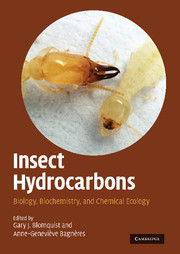Foreword
Published online by Cambridge University Press: 18 May 2010
Summary
As every young chemist once realized or was told, hydrocarbons are simple (even “boring”) molecules of limited practical importance, and even less scientific interest. Certainly this was the situation in the early 1960s when the field of chemical ecology was established. Although it was known that insects and other arthropods seemed to have very high molecular weight hydrocarbons on their cuticle, nothing else was known of their chemistry or of their biological importance, other than that they were possibly involved in water retention. As in many cases in science, progress is sometimes stymied by lack of a particular tool or technique. The invention of gas chromatographs and their coupling with mass spectrometers in this same time period formed the critical impetus for the birth of a major field of science, and the realization that those “simple” hydrocarbon molecules are the end product of eons of evolution, that they are far from simple, and that they are critical elements in an amazing variety of biological roles not only in arthropods, but also in microorganisms, plants, and numerous animal phyla.
By 1980, enough progress had been made in the elucidation of the chemistry and ecological roles of arthropod hydrocarbons to warrant a comprehensive review in the Annual Review of Entomology (130 papers constituted the entire literature at that time). Progress continued unabated in the ensuing years, and in 2005 a second limited review of the progress since 1980 of our knowledge of the chemistry and biological roles of hydrocarbons was published in the Annual Review of Entomology. During this same interval, several other specialist reviews were also published.
Information
- Type
- Chapter
- Information
- Insect HydrocarbonsBiology, Biochemistry, and Chemical Ecology, pp. ix - xPublisher: Cambridge University PressPrint publication year: 2010
